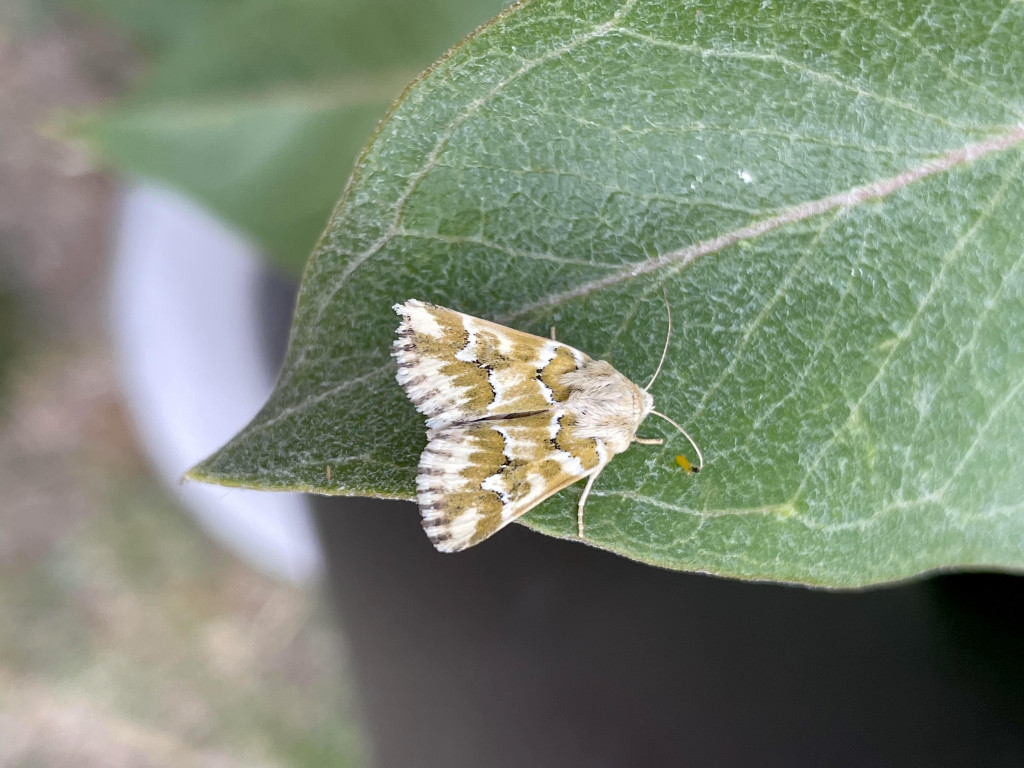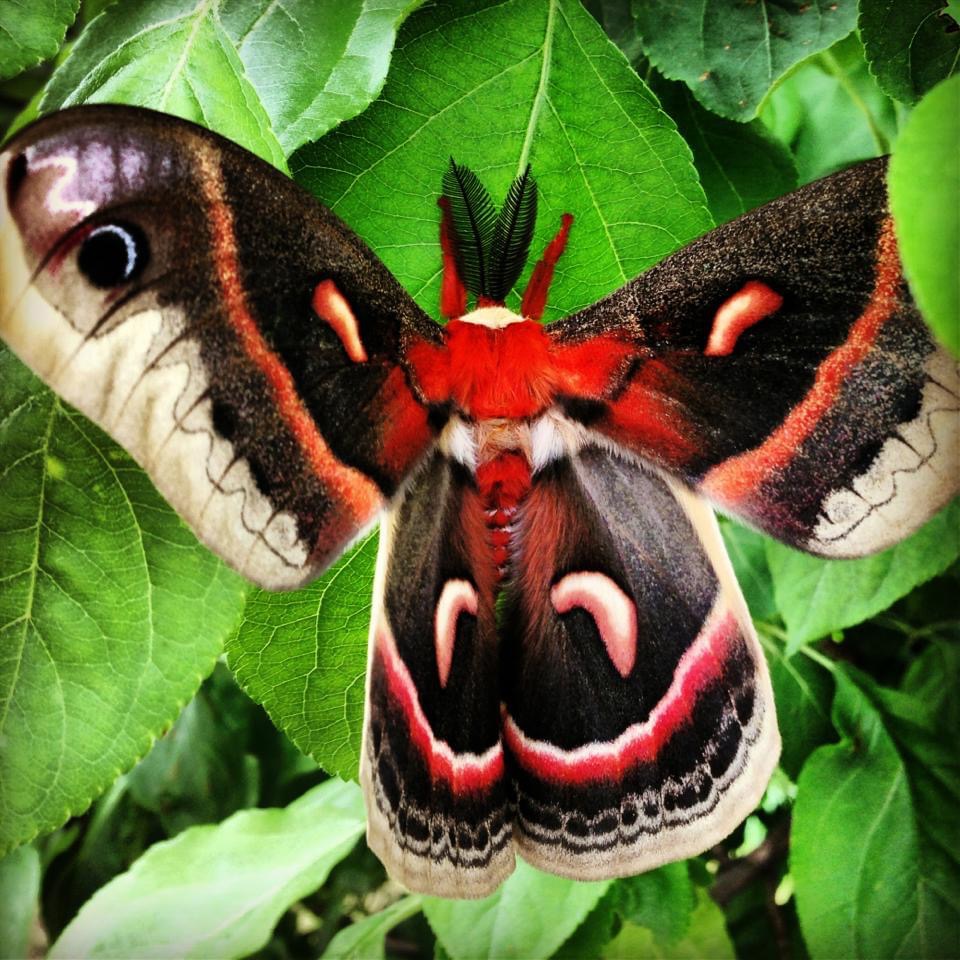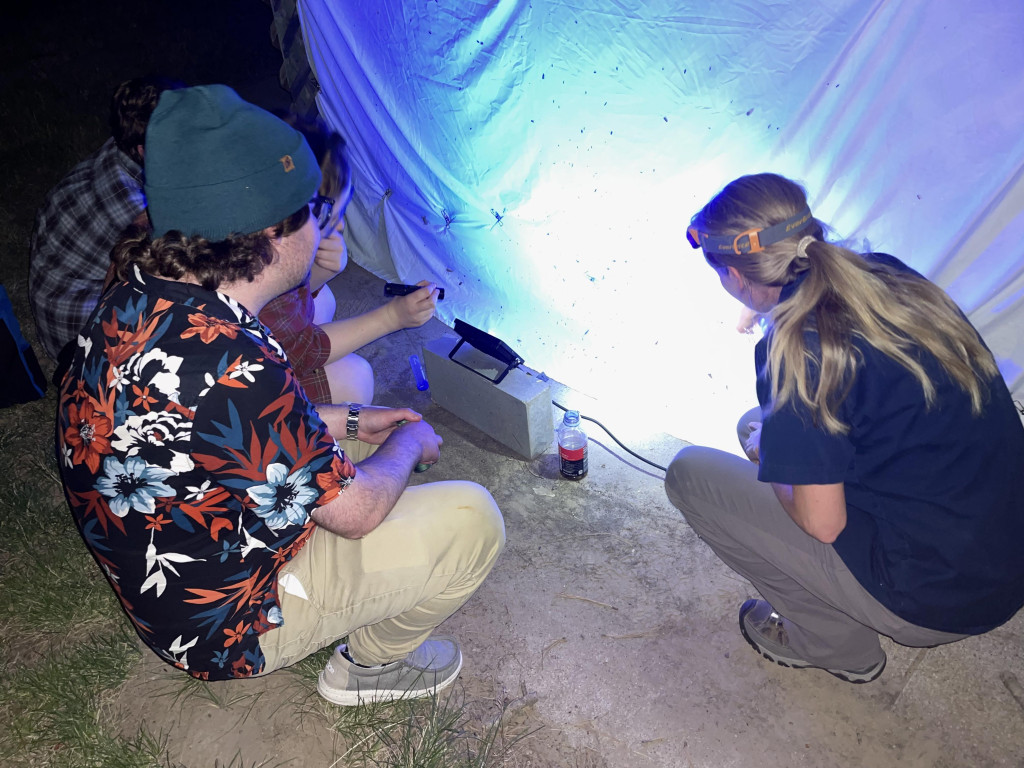
By Olivia DaRugna, Watchable Wildlife Biologist
Moths are not just the dull-brown insects that swarm around your porch lights at night. They are much more interesting and can be quite beautiful. Moths also play important ecological roles as prey for many predators, such as bats and pollinators of night-blooming flowers. Some moths are even indicator species of a healthy environment. July in Nebraska is a great time for observing these incredible insects, and you don’t have to go far. Viewing moths can be as easy as turning on your porch light for an hour and stepping outside occasionally to see what species might have come in.
Notable Moths
The flower moths are often colorful and can be observed during the day drinking nectar from flowers. Their appearance can range from bright pinks, to yellows, to lime green, like the Schinia simplex.
The painted lichen moth (Hypoprepia fucosa) is a pop of color when it appears at your moth lighting setup. Their bright reddish-orange wings with dark gray strips stands out and acts as a warning to predators that they contain inedible chemicals. Some tiger moths have developed a color pattern similar to the lichen moth to disguise themselves as inedible, even though they are edible.
A personal favorite of mine is the carmine snout moth (Peoria approximella), for no other reason than it makes me smile. This tiny moth is just 8 mm in length, about as long as two popcorn kernels, and has a shimmery white and pink appearance. These moths have a long narrow “nose” called labial palps, which are a pair of sensory appendages.
Although not all moths are as shimmery and colorful as the ones described, even brown moths can be beautiful upon close inspection; you’ll notice subtle designs and a wide range of color variations.

For most people, the real showstoppers are the large silkworm and sphinx moths. The cecropia moth (Hyalophora cecropia) is the largest moth in North America and can be found in wooded areas and neighborhoods across Nebraska. The first time seeing this species can be mindboggling. Cecropia moths feature a bright orange body as thick as your thumb and pops of orange and white shapes on their wings. The males use their feathery-like antennas that are covered with hundreds of thousands of olfactory sensors to detect females from over a mile away.
Game and Parks hosts nighttime moth viewing programs in the summer, and when ending a program for the evening, it never fails — a large moth will suddenly fly into our moth lighting setup, prompting a loud gasp from participants. Anxious to see what large creature just landed, they crowd around the sheet to observe, photograph and try to identify the moth. Received by dozens of smiling faces during the late hour, silkworm and sphinx moths are literally the showstoppers, before it is time to shut down the moth light.
How to Observe Moths
It is easy to create your own backyard moth lighting setup, and a few supplies can go a long way to greatly increase your enjoyment and the number of moths you might see. All you need is a light source, a surface for the moths to land on and a camera, so you can document the moths you see.
Starting with the light, it can be as simple as a porch light, flashlight or a desk lamp. If you have access to a black light or mercury vapor lights, these emit a light in a color spectrum that moths find irresistible.
Pale surfaces work best, such as a white sheet clipped to a rope strung between two trees. Some people, myself included, like to drape a sheet over a fence to help keep it from blowing in the unrelenting Nebraska wind. A cotton white sheet works best because it will reflect UV rays from the light, creating a larger surface area to draw in the moths. In a pinch, the side of a building can work, too.
As an extra attractant to your moth setup, add a smelly lure that will draw in the moths. Grab that brown banana that has sat in your fruit bowl too long, a little apple cider vinegar, a pinch of sugar, and if available, a splash of beer or wine. Mix this together, and set it out by your moth lighting setup by smearing the lure on tree bark or splattering it on the sheet – you’ve just made an all-you-can-eat buffet for adult moths. Those moths that can’t eat will still be attracted to the aromatic “perfume.” Take photos of any new moth you see, and upload the images to iNaturalist.
Although staying up late can lead to some great moth observations, you can also see moths at other times of the day. Take a stroll through a garden at dusk, and you may see what at first appears to be a hummingbird, but take a closer look and it might be a hummingbird moth instead. This moth hovers around flowers to suck up nectar with its long proboscis.
Summer is the perfect time to stop and smell the flowers. While you appreciate their beauty, take a second to look closer and you may see moths resting on plants during the day. Pay special attention to native flowers, which attract more moths and other interesting insects.

Resources
Although there is not an all-encompassing field guide to moths in Nebraska, let alone the Great Plains, there are several resources that can help get you started. The Nebraska Lepidoptera website offers detailed species information for three moth groups and has a comprehensive list of all documented moth species in the state. Don’t forget iNaturalist, which is a great tool to help you narrow down unknown moths to families or species: Just submit your moth observation through the app or website. For a more comprehensive list of the many moth species in the United States, visit the Moth Photographers Group website.
Wildlife Viewing Events
Wildcat Hills Bioblitz, July 21-22 – Kicking off the bioblitz Friday evening is a sunset nature hike and moth lighting at the Wildcat Hills Nature Center in Gering. Following Saturday morning are more activities and adventures searching for and documenting a variety of animals.
National Moth Week, July 22-30 – Nebraska Extension and the Nebraska Game and Parks Commission will host Nebraska Moth Week activities, including a moth lighting program July 26 at the Wildcat Hills Nature Center in Gering.
Even if you can’t make an in-person program, you can contribute data on the diversity and occurrence of moth species throughout Nebraska by participating in a week-long moth blitz. See a moth? Take a picture and upload it to the Nebraska Moth Week iNaturalist page.
